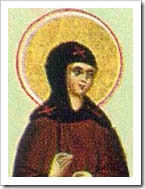|
|||
|---|---|---|---|
| This weekly bulletin insert complements the curriculum published by the Department of Christian Education of the Orthodox Church in America. This and many other Christian Education resources are available at http://dce.oca.org. | |||

Saint Anthusa lived in the eighth century. She is called the Abbess of Mantinea, the place where she led a monastery of 90 nuns. It is located in Paphlygonia, a province in what is now Turkey. To understand how devoted Anthusa was to the true faith, it's necessary to know about another person who was her contemporary, and who was dedicated to something quite different. That person is the Byzantine Emperor Constantine V, who ruled from 741 to 775. He was the son of Leo III, who had taken a public stand against the veneration of icons in the year 726. Like his father, Constantine was dedicated to battles and military victories. He had to establish his rule by fighting his brother-in-law, and once he had done that he turned to securing the borders of the empire. He fought, and then established a truce with, the Moslem Arabs on the eastern border. On the northern border were the Bulgars, who fought against him in battle after battle. He often won these battles, but the Bulgars would be his strong adversaries for the rest of his life. Perhaps Constantine also inherited from his father his fierce opposition to the veneration of icons. Though a baptized Christian, he saw no value in the relics of saints, and writings from the time claim that he actually hunted for them so that he could collect them and order them to be thrown into the sea. As for icons, he argued that God cannot be depicted as a human being (ignoring the fact that God has shown Himself as a human being in the Person of Jesus Christ). He hated monastics partly because they were the strongest defenders of icon veneration, and persecuted them without mercy. As the emperor carried out public terror and wrote treatises about his opposition to icons, Saint Anthusa privately lived the life she always had, given to prayer and to quietly venerating icons in her secluded retreat in the mountains. Despite the danger, 90 other women joined her. She became their abbess and they were willing to face any persecution with her. Their dedication could not be shaken even by the fact that their government would willingly imprison, torture and perhaps kill them for it. In fact, Anthusa actually was arrested and tortured because she would not renounce icon veneration. But she was finally released and allowed to return home, where she died in peaceful old age. In I Corinthians 7: 12-24 Saint Paul praises another kind of dedication: that of a believing wife or husband to an unbelieving spouse. Paul says that the unbelieving spouse is "consecrated" through the believing one. Through dedication to the faith, and to the spouse, the believer may bring about the other's salvation. There are many things to which people can dedicate themselves. Saint Anthusa reminds us that the best ones may bring suffering in this world, but glory in the next. |
|||
